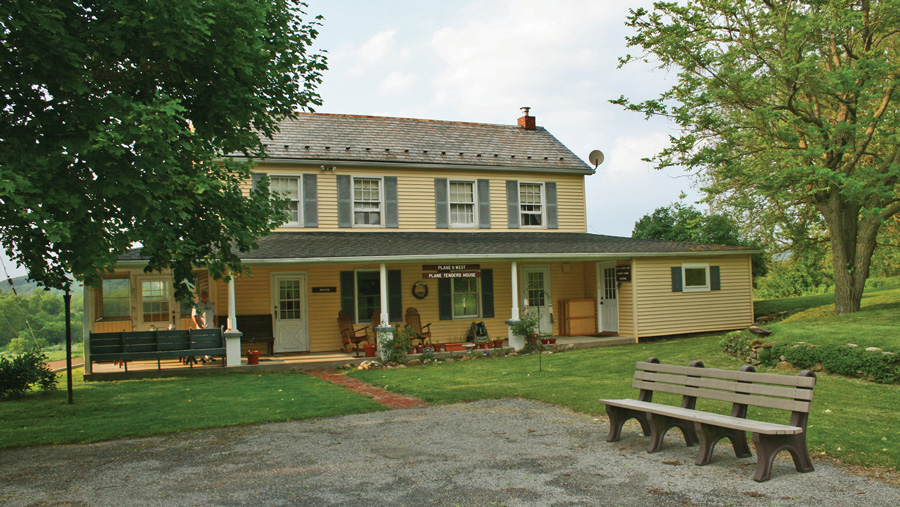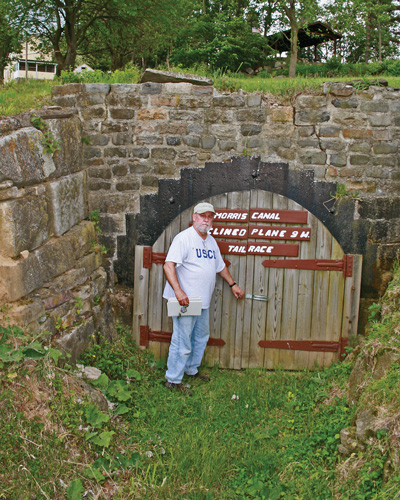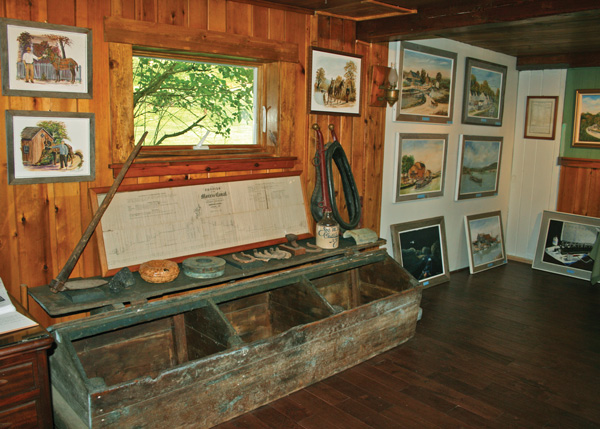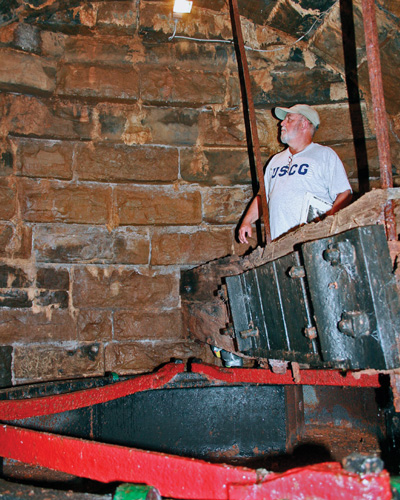Thousands of people over the years have visited the home in Warren County where Jim and Mary Lee raised their five children, but Jim Lee, Jr. figures his fifth grade class took the first tour his dad ever gave, back in 1953.
"That's probably the first trip ever," Lee, Jr. said, recalling that his class walked from the old Stewartsville School on North Main Street, Greenwich Township, a mile or so away.

What made the Lee household worth the walk was the property's history, much of which was still buried on that day in 1953. Jim Lee, Sr., a railroad conductor who grew up in Phillipsburg, was so fascinated with the Morris Canal that he bought what had been the site of one of the canal's inclined planes, and moved his young family to a trim two-story house where the man who operated the plane had lived.
Within a few years, Lee Sr. began to excavate the remains of the canal plane and the powerhouse that operated it, and embarked on an avocation that resulted in him becoming one of the foremost experts on the Morris Canal. His book The Morris Canal, A Photographic History was first published in 1973, and reprinted several times. That publication, along with his 1977 history, Tales the Boatmen Told, piqued interest in the canal that conquered the hills of northern New Jersey.
Lee was born in 1917, only a few years before the canal ceased operating in 1924. During his youth, some canal sections still held water, and boatmen could still be found. "He grew up in Phillipsburg, and did get in on the tail end of old canalers being there at the boat basin in Phillipsburg," Lee Jr. said. "He and his buddies would build a raft out of old junk, and paddle around the boat basin," the son added, explaining the boys would hear stories from the old tiller sharks and other canal workers they encountered.
Lee grew up and married a local girl, Mary Mann. "He didn't really know when he met her that her family was involved in the canal," their eldest son said, but his interest in the Morris Canal was rekindled by hearing stories from his mother-in-law, Isabelle Lenstrohm Mann, whose father and grandfather had been a canal boat captains. In fact, Isabelle was born on a canal boat, somewhere between Washington and Hackettstown.
The Lee family started out in a home located at Plane #10 West, living with Isabelle Mann (Jim Lee, Jr. lives next to that house today). In 1946, Lee Sr., home from serving in World War II and working on the Central Railroad of New Jersey, bought what had been the plane tender's house at Plane #9 West, and within a few years started his own archeological dig there.
When the canal was abandoned in the 1920s, the owners dismantled the above-ground structures for the planes, and pushed the demolition rubble into the underground chamber that held the turbine and gears. What the canal company pushed into the hole, Jim Lee wanted to take back out.
"As early as 1957, we were trying to excavate the turbine hole," said Lee Jr., who is now 65 and retired. Work went slowly at first, all done by hand, until Lee Sr. made a deal with someone he knew who owned a tow truck. "Once we had that tow truck, it only took us three weeks to excavate both of those holes," Lee Jr. said, referring to the turbine hole and the separate chamber for the penstock, where the water dropped from a height of 47 feet to power the turbine.

After clearing away the rubble that filled the hole, Lee found the turbine still there, although broken and tilted on its side. Eventually, the turbine hole was restored so that Lee could take visitors through the tailrace -- the tunnel that carried the water out of the turbine -- up to the turbine room itself, to see how the inclined plane was powered.
In years past, a visit to the Lee property was a more informal thing. Except for an annual bus tour of canal sites conducted by the Warren County Morris Canal Committee, a visitor would have to contact the Lees or just stop by for a look. "We'd be having Sunday dinner, and people would come up the lane and interrupt dinner. My dad would always go out, and my mom would have to put his dinner aside," Lee Jr. said, although he added, "I don't think they ever turned anyone away from a canal visit."
After Mary Lee passed away in 1998, Jim Lee, Sr. agreed to sell the property to Warren County, while retaining life rights to the house. After his death in 2007 at age 89, the county and canal buffs, including Lee family members, came up with a management plan for the property and turned part of the house into a museum.

The museum room inside the planetender's house is located in what was a playroom when the Lee kids were growing up. Jim Lee, Sr. later used it as an office, crammed with canal photos, information and memorabilia. The desk where he worked on his canal research is still there, now holding a television that plays slide shows of Lee's photos and literature about the canal. The room contains a variety of canal artifacts, like the tiller and a feed box from a canal boat, a mule collar, and the conch shell that Mary Lee's grandfather would blow to alert the lock tenders of the approach of his canal boat. In one corner is a "Boatman's Cook," a small cast iron stove used on the deck of a canal boat, its short chimney intended to allow it to pass under the low bridges over the canal. Diagrams and paintings of canal scenes adorn the walls, and a model of a canal boat in an inclined plane cradle car dominates a table on one side of the room.
A visit also includes a walk around the property to see remnants of the inclined plane, displays of canal artifacts found there, and a trip through the low tailrace tunnel into the turbine chamber, its damp walls now showing stalactites produced as water seeps through the lime mortar in its cut stone walls.
Tour and museum guides are volunteers from the county's canal committee, and Lee family members, including Jim Lee, Jr., his son, Jim Lee III.. "I doubt that I would still be volunteering and doing this if it weren't for the family history part of it," Lee Jr. said, pointing out the connections his parents, grandparents and great-grandparents had to the canal. "But the engineering of it, the pure history of it, interests me."
The once-a-month hours coincide with those at another county-owned canal site, the Warren County Historical Learning Center at Bread Lock Park, named for a canal lock near New Village in Franklin Township where a store sold provisions including fresh-baked bread to canalers. The park includes some remnants of the canal, a working model of Lock #7 West - the "Bread Lock" - as well as models of Plane #7 West in the Bowerstown section of Washington Township.
Visitors can see other Morris Canal sites elsewhere in Warren County. In Phillipsburg, the stone arch that marked the entrance to the canal still stands at the edge of the Delaware River at Market Street off South Main Street. Canal boats carrying coal on Pennsylvania's Lehigh Canal swung across the river and onto the Morris Canal to continue eastward. In Hackettstown, visitors can stroll the towpath where the canal runs through a wooded area at Florence W. Kuipers Memorial Park. Another good spot for a hike along the former canal towpath is in Allamuchy Mountain State Park. At Saxton Falls, Guard Lock 5 West allowed canal boats to move between the canal proper and a section of the Musconetcong River. Although the lock has been filled in, the tops of its stone walls are visible, and the outline of a canal boat is painted on the ground, giving a good idea of its size of the close fit in a lock.

Think of it as an engineering marvel that climbed the hills of North Jersey, or picture a scene from bygone days as a pair of mules towed a boat at a leisurely pace. Either way, some basic understanding of the history and technology involved will enhance a visit to any of the Morris Canal sites that are available to the public.
Opened in 1831 with a 90-mile route between Phillipsburg and Newark, the canal was expanded in 1836 to Jersey City, making it a 102.15-mile trip between the Delaware and Hudson rivers.
What really distinguished the Morris Canal from other 19th Century waterways was the use of the inclined plane. While the canal also employed locks for elevation changes of up to 20 feet, it utilized 23 inclined planes for the larger elevation changes. Plane 9 West, where the Lee family lived, surmounted the greatest change in elevation, raising and lowering boats 100 feet using the 1,600-foot-long plane.
To envision the inclined plane, picture a boat trailer that you back into the water to drop off or retrieve your boat: The boat floats on or off the trailer, which pulls the boat out of the water and takes it to water in another location. When using the inclined plane, a canal boat floated onto the cradle car, which ran on a set of tracks. A long cable attached to either end of the cradle car moved it on the tracks, and after the boat was either hauled up the slope or lowered down it, depending on the direction of travel, it floated back into the next watered section of canal and went on its way, towed by its mule or horse team.
In its earliest days, the canal used a simple waterwheel to turn the pulleys that wound and unwound the cable. By the 1860s, the canal had been enlarged and upgraded to use a Scotch reaction turbine to operate the inclined plane. Water flowing from the upper level of the canal cascaded down a J-shaped tube, causing the massive cast iron turbine on the short side of the J to float a fraction of an inch from the water pushing up from below and begin to spin. Soon the turbine was rotating at 67 revolutions per minute and spinning the attached gears, providing the muscle to move the thousands of feet of three-inch-thick cable that attached to the cradle car, raising and lowering boats that when laden with cargo could weigh 70 tons or more.
Coal was the canal's main freight, fueling the iron operations throughout northern New Jersey and spurring much of the state's Industrial Age growth. However, iron ore and iron products, lime, farm produce, bricks, hides, lumber, manure, and cider, beer and whiskey were among the goods hauled on the Morris Canal.
The only time the canal operated profitably was in the 1860s -- the need for transporting goods during the Civil War helped with that -- but the canal struggled on to the 1920s before it finally went out of business, falling victim to faster transportation modes including the railroads.
The Centenary Stage Company produces professional equity theatre and also a wide variety of top-flight musical and dance events throughout the year.
Choose and Cut from 10,000 trees! Blue Spruce, Norway Spruce, White Pine, Scotch Pine Fraser Fir, Canaan fir, Douglas Fir. Family run on preserved farmland. Open Nov 29 - Dec 23, Tues-Sunday, 9-4. Easy Access from Routes 78 or 80.
Consider Rutherfurd Hall as refuge and sanctuary in similar ways now, as it served a distinguished family a hundred years ago.
The 8,461 acre park includes the 2500-acre Deer Lake Park, Waterloo Village, mountain bike and horseback trails.
Local roots!